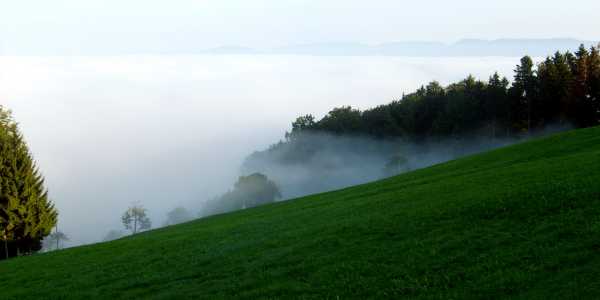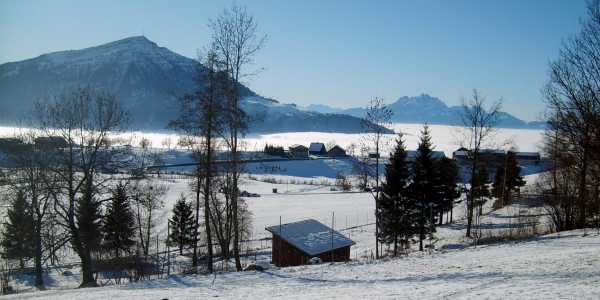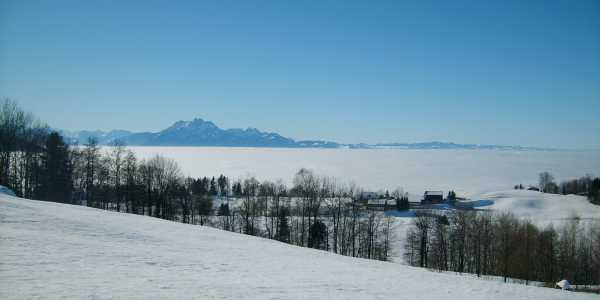Fog4Cast
Towards an operational fog forecasting system
Context
Fog events have a strong impact in many fields of human life; economic losses can be comparable to those of tornadoes and storms. It is not surprising that the external page World Meteorological Organization (WMO) classifies fog as a severe weather category, together with (i) tropical cyclones, (ii) heavy rain/snow, (iii) thunderstorms, and (iv) gale force winds. The obvious effect of fog is a reduction of visibility, which is a serious aviation traffic hazard. Thus, improving operational prediction skills of weather forecast models if of great importance.
Overall Aim
Numerical prediction of fog at a degree of detail that is useful e.g. for air traffic applications is still not satisfactory with state-of-the-art weather prediction models. Thus, our goal is to advance fog forecasting performance in the complex terrain of Switzerland by further developing the Swiss weather forecasting model running at unprecedented resolution. Our vision is to approach a qualitatively acceptable 24-hour fog prediction time horizon that would allow long-distance flight operators to use detailed and precise forecast information for their arrival at Zurich Airport and at similar airports worldwide.
Work Packages
In Switzerland the COSMO-1 prognostic weather forecasting model with a 1.1 km horizontal grid cell size has become operational in March 2016 and offers an unprecedented possibility to move towards better forecasts of fog which requires a horizontal model resolution on the order of 1–2 km or better. Thus, COSMO-1 and the new data assimilation system KENDA are an ideal breeding ground for this task.
However, COSMO-1 does not include detailed cloud microphysics tailored for fog; its standard module is based on a bulk saturation scheme, does not contain cloud droplet sedimentation and assumes a fixed droplet size distribution. Hence its use for prognostic forecasts of fog by the model is extremely limited. Due to these shortcomings, forecasters rarely rely on raw model output for issuing fog forecasts and apply empirical forecasting rules to complement their experience. Thus, we aim to improve model prediction skills for fog conditions as well as to develop and test the modeling system within Fog4Cast.
Impressions
 The Früebüel Swiss FluxNet site in winter (January) with an extended fog deck covering the Reuss valley. Mount Rigi at left, mount Pilatus in far back
The Früebüel Swiss FluxNet site in winter (January) with an extended fog deck covering the Reuss valley. Mount Rigi at left, mount Pilatus in far back An ideal condition with a fog deck covering most of the Swiss Plateau. Present-day weather forecast models still struggle to correctly predict extent and upper boundary of such fog decks
An ideal condition with a fog deck covering most of the Swiss Plateau. Present-day weather forecast models still struggle to correctly predict extent and upper boundary of such fog decks
Publications
Westerhuis S, Fuhrer O (2021) A locally smoothed terrain-following vertical coordinate to improve the simulation of fog and low stratus in numerical weather prediction models. Journal of Advances in Modeling Earth Systems 13: e2020MS002437, doi: external page 10.1029/2020MS002437
Westerhuis S, Fuhrer O, Bhattacharya R, Schmidli J, Bretherton C (2021) Effects of terrain‐following vertical coordinates on simulation of stratus clouds in numerical weather prediction models. Quarterly Journal of the Royal Meteorological Society 147: 94-105, doi: external page 10.1002/qj.3907
Westerhuis S, Fuhrer O, Cermak J, Eugster W (2020) Identifying the key challenges for fog and low stratus forecasting in complex terrain. Quarterly Journal of the Royal Meteorological Society 146: 3347-3367,doi: external page 10.1002/qj.3849